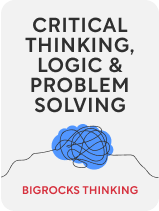

This article is an excerpt from the Shortform book guide to "Critical Thinking, Logic & Problem Solving" by Bigrocks Thinking. Shortform has the world's best summaries and analyses of books you should be reading.
Like this article? Sign up for a free trial here.
What’s inductive reasoning? How can it help you understand an issue and build a convincing argument?
Critical Thinking, Logic & Problem Solving explains how to apply critical thinking to solve problems more effectively. A major step in the process is forming an argument from the information you’ve gathered in order to move toward a solution—and even persuade others to adopt your way of thinking.
Here’s the authors’ advice on how to construct an argument that helps everyone clearly grasp the problem and embrace a path forward.
How to Construct an Argument
Once you have relevant information and you’ve assessed its reliability, you can review the information you’ve gathered to see what arguments you can make from it. The authors of Critical Thinking, Logic & Problem Solving offer recommendations for how to construct an argument.
They suggest using inductive reasoning, which consists of 1) making observations and identifying patterns in your information, 2) identifying questions that arise from these observations, and 3) drawing conclusions that answer those questions.
Step 1: Identify Patterns in Your Information
Patterns help us understand information and form arguments. For example, if you’re feeling resentful toward your partner and you don’t know why, you might notice a pattern in your relationship where your partner spends every weekend relaxing while you do all the housework.
(Shortform note: Pattern recognition is an important skill that helps us understand situations and make decisions. Some people are born with more advanced pattern recognition skills than others, but anyone can cultivate them through practice and study. Patterns occur in many different disciplines, especially art, nature, and mathematics, and studying the patterns in these fields can help you recognize patterns in other contexts. Where inductive reasoning comes in is in predicting further sequences in a pattern based on what you’ve seen already.)
Step 2: Identify Questions That Need an Answer
Identifying questions that need an answer will tell you what type of argument or solution you need to come up with. Your question or problem should not only lead you to an answer but should also help you learn more information. For that reason, you should avoid yes or no questions, as answers to these will be simplistic and may not yield any real solutions. Additionally, use neutral language when forming your question to avoid biasing the answer. For example, asking “Why won’t my partner contribute to the housework?” will result in fewer, more biased answers than “How do I feel about the balance of labor between me and my partner?”
(Shortform note: Questions with yes or no answers or non-neutral language are types of leading questions, which means they push the answerer to a specific response rather than an organic one. Phrasings like “How satisfied were you…” and “Which thing did you like…” assume the listener had a positive experience and excludes answers that reflect negative experiences. Phrasings like “What did you think…”, “How do you feel…”, or “What are some ideas…” will give you more objective information and better guidance toward the problem you’re trying to solve.)
Step 3: Draw Conclusions
Use the information you’ve gathered to draw inferences. These inferences serve as logical foundations for the formation of your arguments. For example, based on the pattern you’ve observed and the question you’re asking about the balance of labor between you and your partner, you may conclude “I feel resentful toward my partner because I feel I do more of the housework than they do, and I would like them to do more.”
(Shortform note: The authors don’t address how to use your inferences to form your argument. Your argument is the persuasive statement you make to the opposing party to convince them to accept your claim. You would use the conclusions you formed during the analysis process to create a proposition, backed up by the evidence you’ve gathered, and present that to your audience in order to get them to agree with you. In our example, the argument you would present to your partner would be “If you do more of the housework, I will feel less resentful.”)

———End of Preview———
Like what you just read? Read the rest of the world's best book summary and analysis of Bigrocks Thinking's "Critical Thinking, Logic & Problem Solving" at Shortform.
Here's what you'll find in our full Critical Thinking, Logic & Problem Solving summary:
- A step-by-step guide for improving critical thinking and problem-solving skills
- Tips for conducting better research and finding reliable resources
- How to improve your communication and storytelling skills






